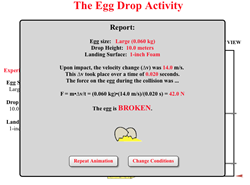 Egg Drop Activity
Egg Drop Activity
Resource:
Egg Drop Interactive
Egg Drop Exercise
Grade Level: High School
Description:
This simulated egg drop provides an engaging way for learners to mimic the iterative modeling process used by engineers in designing a product as they explore impulse and momentum. Select an egg size (small, large, jumbo), a drop height from 1-10 meters, and a landing surface (hard floor, 1-inch foam, or foam box). Set the initial conditions and watch the simulation – will the egg break, crack, or land safely? The Impulse-Momentum Change Theorem is used to automatically calculate the amount of force on the egg at impact. This conceptual exercise is designed to promote scientific reasoning as students examine the importance of controlling variables in experimentation. The accompanying multiple choice exercise asks students to analyze which experimental conditions result in optimal outcomes and why.
Performance Expectation:
Force and Motion (HS-PS2-3): Apply scientific and engineering ideas to design, evaluate, and refine a device that minimizes the force on a macroscopic object during a collision.
Engineering and Technology Standards: Optimizing the Design Solution
HS-ETS.1.C Criteria may need to be broken down into simpler ones that can be approached systematically.
This activity aligns with the three dimensions of the Next Generation Science Standards in the manner described below:
Forces and Motion (HS-PS2.A.3): If a system interacts with objects outside itself, the total momentum of the system can change; however, any such change is balanced by changes in the momentum of objects outside the system.
|
The simulation depicts a physical situation where an egg interacts with 3 different objects: a hard floor, a one-inch piece of foam, and a foam box. Students will be using the computational model to learn how the velocity change over specified time periods affects the amount of force on the egg at impact. It also explores how the mass of the egg is related to its momentum. |
Stability and Change – Grades 9-12: Systems can be designed for greater or lesser stability.
|
The interactive simulation allows students to select different types of landing surfaces for their egg drop experiment to determine which surface provides greatest stability. The egg will break when dropped on the hard floor, but which of the other two surfaces produces greater stability? Running trials on the simulation will allow students to form a conclusion. |
| Asking Questions and Defining Problems – Grades 9-12: Ask questions that arise from examining models to clarify relationships. |
The NGSS calls for high school students to evaluate design problems using models and simulations, which is exactly what this activity lets them do. They are given the task of defining the parameters necessary to reduce the force of impact on a dropped egg. |
| Analyzing and Interpreting Data – Grades 9-12: Analyze data using computational models in order to make valid and reliable scientific claims. |
In the supplementary exercise, questions are posed that require students to interpret the data from the simulation to make valid conclusions. (Example: When a jumbo egg was dropped from 5 meters onto a 1-inch foam surface, it fractured. Which of the following changes in conditions would lead to a safe landing?) |
Associated Reading from The Physics Classroom
Other Supporting Pages at The Physics Classroom:
View
Infographic.
Search the NGSS Corner
Maybe you're looking for something really specific that pertains to a desired topic and emphasizes one or more of the listed NGSS dimensions. Why not try a search of this section of our website? Simply select from one or more of the pull-down menus and click Search. This page will reload and a collection of possibilities will be displayed in this section of the page and sorted by relevancy.